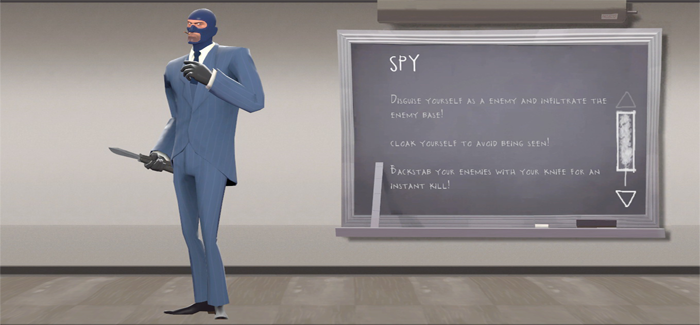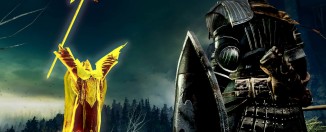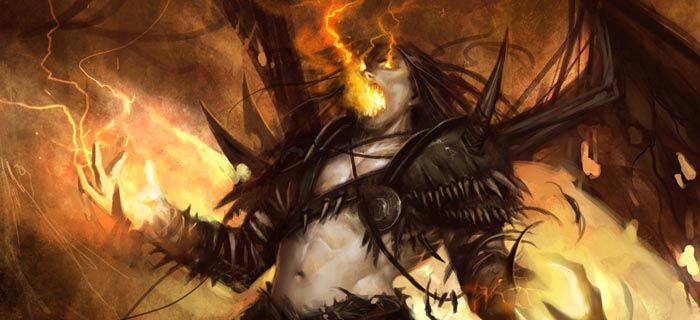TF2 Spy Strategy: A return to my roots
My last spy article was almost a year ago now, sometime in mid-March of last year. I’ve been watching stabby’s videos again, and it’s got me itching to get back on the old TF2 for some laughs and back poking. Without access to a workable PC at the moment, I’m stuck talking and watching. Since I’m done watching, I’ll start talking.
Today’s topic is prediction, something monsieur stabby stabicron is almost preternaturally good at. And we’re all about prediction when playing as spy, not that braindead soldier or smashed-out-of-his-head demoman. This is a discussion among gentlemen; men of higher tastes and handsome suits. Men capable of mass murder while still getting home to scout’s mother in time for dinner.
For most of you, all of what I’m about to say will seem tedious and boring, because you already know it. I think hearing the ground rules again is always a good refresher, so read on anyway.
Prediction 101
There are five tenants of prediction all spies should know.
1. How a player will act when no threats are apparent.
2. How a player reacts to new, unknown threats.
3. How a player reacts to non-spy threats.
4. How a player reacts to a spy’s presence.
5. How a player reacts once they believe the threat, spy or not, is dealt with.
But first, let me reiterate.
All spies must have significant time in the other eight classes. I cannot stress this enough. I think at least twenty to thirty hours* is just about suitable. I don’t suggest that you go through them in order, or hammer out all that time on a class by class basis. But I do believe no player truly understands each class at a fundamental level until they’ve put in the work. As in most all of stabby’s annotated videos, he says that he wants his enemies to act predictably. How do you think he knows that (besides the 1000 hours in spy watching)? If you look at his stats, he has in fact played more than forty hours in every single class. He knows how they move when they’ve seen a spy.
His strength is defying their expectations.
Now lets dig into that list.
Stage 1: All clear.
Players are the most predictable at this stage. There is no looking around, no random spam; everyone’s running in a straight line. As a spy, this is how you want your enemies acting as much as possible. They’re a bread basket and you’ve got the butter and slicer. Players act this way most often coming out of spawn when they have a couple points and need to hoof it. To this point, you as spy probably haven’t caused too much havoc, or you’ve just respawned and they know you’re out of their hair for a few seconds. This article isn’t about how to get them that way, so I’ll save that topic for another time.
Stage 2: Who’s there? I know I heard something…
This is the most dangerous stage, and one to keep to a minimum. When anyone knows there’s something threatening them but not what that is, everything is that danger. They jump at shadows, allies become possible enemies, enemies fade into one RED/BLU blur. Most important to your survival is their disregard of the objective. Minimizing the danger is their primary goal, and until they know where the hits are coming from, this stage continues.
To alleviate this problem, you as spy have three options, provided you are the one who initiated the attack. First, stab them and put them out of their misery. Second, allow the hit notification to point them in your direction so they can move to stage four. Third, break off the engagement and let them return to either stage one or three.
My advice is never deal with an enemy in this stage. They are anathema to your unpredictability, because yours is calculated, theirs instinctual, and they operate on a deeper, faster level in the brain than you can. Barring your own missteps, only the best or luckiest spies glean anything from players in this stage.
Stage 3: We must poosh leetle kart!
I’m going to lump players on or around an objective into this group, because the two really go hand in hand. When any given class is fighting any other class that isn’t spy, you should know how they’re going to act. You’ve been in that situation. The easy kills remain snipers, the deadly ones pyros for their random flame in all directions.
I consider this the middle difficulty stage, ahead of stages two and four but behind one and five. For this reason, caution remains a concern, but you have license to be aggressive. Players unaware of your presence but engaged with other classes are really only a threat once you enter their immediate vicinity, where the actual damage is being dealt. Assuming you’re behind enemy lines, your only jobs are assessing the situation and identifying primary targets. The heavy will keep his gun revved and firing around the cart. The demoman will circle shooting stickies. The soldier will run just so far before jumping. You get the idea.
With the pieces on the board, you need only pick the first to have some tea and death with you. Once committed, do not be afraid to switch targets at the last second. TF2 is a chaotic game, and sometimes the best laid plans fall apart in an instant. If need be, abandon the kill and reconsider. If still undetected, all you’ve lost is time, and in most situations, that’s something you always have a little more of.
Stage 4: Hey boys, it’s a spah!
So here’s the heart of the matter, and the one thing stabby capitalizes on most in his videos. More than half of his victims know exactly where he is, but not how he’ll move. You should do the same. This is the stage that should immediately follow stage two, if you’ve done your job. Once again, because you’ve played the other classes, you know how the average player will approach you: confident that you’re already a dead Frenchman with no friends to mourn him. If you haven’t played enough, here’s the basic premise. 95% percent of players, enemy spies included, will invariably run straight at you firing their weapon or attempting to murder you in other, as yet undescribed fashions.
The ways of putting a blade between their shoulder-blades are endless, but one rule remains constant.
You are in control of their fate, and their fate is to die.
For those of you without the recommended experience, here’s how I suggest going about following that rule. Do not immediately go in for the kill. Survey the surroundings and acquire the high ground. Even if you aren’t the greatest at trick-stabs, verticality is far more forgiving of mistakes than flat ground. Again, most players will run straight at you. Smarter players will backpedal and move around. Watch them for not more a second or two, keeping the pressure on with your pistol.
Good players tend to have set distances traveled before shifting direction, and in those couple seconds, take a quick stock of how long each shift takes. With this information, move the opposite way of where you predict they’ll move. Then, as they shift to keep distance between you, shift yourself back towards them. Done correctly, you’ll have led them right to you.
What I just described is a basic lure-to-snap stab. It is a maneuver wholly dependent on prediction, as are all trick stabs. If at any point during the above you make an error and the tables turn against you, move to stage five in the most expeditious manner possible. Sometimes, though, sacrifices are necessary, but go down fighting.
Stage 5: It was probably nothing…
So you need to escape. This is cloak management time and backtrack time. I don’t mean backtrack to your spawn. I mean back to theirs. And I don’t mean their current one. I mean the one before it. Both you and the enemy team need to catch some breath.
Once a fight’s gone sour, get into cloak. Move in one direction, keeping your enemy in view. Once fully invisible, switch directions, wait a few moments, then do so again. If you must, do it a third time. At all times, keep tabs on your pursuer. Because they will pursue you. This in itself isn’t a bad thing. It’s one player out of the action, away from the objective. Some will give up, some won’t. Get away from both. Find a shady spot to wait in view of their spawn and just watch. Most players spawning won’t think a spy’s watching them, making them effectively set in stage one. The callout of spy will, however, set a few players on edge. Your job for the moment is to exercise a little patience. It’s only around a fifteen to twenty second wait at the most. Players move into stage one quickly back at their spawn.
When near the objective but not directly engaged, players unaware of any threats will be doing one of three things. One: heading towards the objective. Two: looking for health. Three: looking for ammo. The first is easy to exploit. The second usually comes from medics, and while those juicy medic kills are nice, sometimes using the medic himself as bait will lead to far greater rewards than the one health-filled back could offer. The third is the primary prerogative of the engineer, who provides a dispenser. Players not near a medic flock to such locations, and a teleporter isn’t far either. Predicting how populated a dispenser will be comes with practice, but the closer it is to the front lines, the more people will flock to it. As an observer, know how frequently the enemy team pushes, and time your strikes at intervals accordingly. If you want to be aggressive, start your attacks right before everything gets going. Passive spies wait for those lulls in the action, and remove support from any pushes to come.
A good spy does both.
A great spy didn’t need to read this article.
WiNG’s no stranger
If you watch WiNG’s old spy videos (make more!), and you manage to slosh through the bad jokes and terrible impressions**, you’ll see he’s got the above down as well. While WiNG’s not as fancy as stabby with his espionage, the basic premise remains. Both of them know how the standard soldier/pyro/engineer etc. will react given the situation and all its variables.
*Yes, that much.
**Really, they’re terrible! And I should know, I’m a terrible squirrel.








To me, a lot of this seems like a great instruction manual for CnD Spies, a good tip refresher for IW Spies but it doesn’t seem to lend itself to DR Spies too well. Am I missing something?
Hmm. I didn’t have a particular watch in mind while writing it. But you might be right. CnD spies do a lot of observing, and DR spies are far more aggressive.
In either case, however, part of prediction is also disguise use, which this isn’t about. I suppose a companion article might be in order, if such is the case. Much of the observation takes place uncloaked, or that was my assumption. Movement from stage two to four, for example must take place while visible to enable weapon use.
And stage three requires the proper disguise, positioning and hiding spot.
I’ll put links in for other articles covering those topics, since I don’t think any one spy strategy article covers everything.
Good read, like always Xiant. I have 4 pieces of advice to give any spies out there, that seem to work for me.
1: Reloading your revolver while disguised imitates whatever weapon you have out’s reload (if it has one). Some people seem to just completely disregard people who are reloading, took me a while to start spychecking everything.
2: Use noisemakers. Strangely enough, using a noisemaker while disguised also makes people think you’re not a spy.
3: Running around as a medic with your melee out screaming spy makes everyone paranoid, and everyone spychecks everyone but you. Pretty funny.
4: If you aren’t playing spy, spycheck, everything. Be in stage 2 all the time. It’ll save your neck a lot of the time. Nice read Xiant, hope for something equally awesome next time.
Yea…for some reason I do so much better as spy with Saharan Spy set without the hat with dead ringer. Why?
It might be revealing a weakness in your standard spy playstyle. What is the one action that makes your stabs successful without a disguise that with one you don’t do so well?
It might also be that players nowadays are so used to seeing the full Saharan set, not having everything puts them off balance.